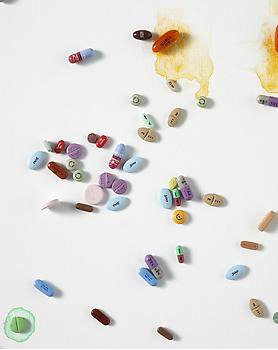Damien Hirst
dal 10/10/2010 al 19/11/2010
Segnalato da
10/10/2010
Damien Hirst
Gagosian Gallery 2, London
Poisons + Remedies. In his latest series, Hirst continues to explore the dichotomies at the core of human existence, through formal means such as color (black and white) and scale (large and small). In Poisons, single images of human skulls are silkscreened in black UV ink with charcoal onto large-scale canvases. In the Remedies, Hirst provides an ambivalent, disconnected antidote to the darkness of the Poisons.

When you look at pills, they look so perfect, so pure. It’s hard to believe that each one comes with a list of side effects as long as your arm.
Damien Hirst
Gagosian Gallery is pleased to present new paintings by Damien Hirst from two series, Poisons and Remedies.
In recent years, the skull has been a recurrent icon in Hirst's paintings and sculptures, most notably in the jeweled death's head, For the Love of God (2007); in monumental spin paintings such as Beautiful Ahura Mazda Intoxication Painting (2007); and in the "blue paintings" such as The Meek Shall Inherit the Earth (2008), which were exhibited at the Wallace Collection, London in 2009. In his latest series, Hirst continues to explore the dichotomies at the core of human existence, through formal means such as color (black and white) and scale (large and small).
In Poisons, single images of human skulls are silkscreened in black UV ink with charcoal onto large-scale canvases. Each painting is of an evidently different skull and titled after a toxic chemical preparation, for example Thallium and Botulinum, to conflate the identity of each ghostly visage with a possible cause of death. The subtle variations in the skulls hint at the individual differences that characterize a face, while underscoring the assimilative equivalence that occurs in death.
In the Remedies, Hirst provides an ambivalent, disconnected antidote to the darkness of the Poisons. Colored resin and plaster pills are scattered across a white painted ground, creating a topography of clustered and chaotic arrangements. In From Safety to Where (2008-2009) and These Days (2008-2009), he adds washes of watercolor to mimic the residue of identifiably branded pills, which appear to seep into the canvas. Remedies expands on earlier works that have incorporated pharmacological elements in sterile, stainless steel medical wall-mounted cabinets and in enlarged photorealist paintings.
By juxtaposing symbols of mortality and toxicity with antidotes, Hirst depicts the ongoing struggle between the forces of dark and light in contemporary life. Poisons and Remedies reminds of the tenuous boundaries between life and death, acknowledging the life-altering role of science while alluding to the redemptive powers of art.
The exhibition will be accompanied by a fully illustrated catalogue with an essay by the novelist Gary Shteyngart.
Damien Hirst was born in 1965 in Bristol, England. Solo exhibitions include "The Agony and the Ecstasy," Museo Archeologico Nazionale di Napoli, Naples (2004); "A Selection of Works by Damien Hirst from Various Collections," Museum of Fine Arts, Boston (2005); "Damien Hirst," Astrup Fearnley Museet fur Moderne Kunst, Oslo (2005); "For the Love of God," Rijksmuseum, Amsterdam (2008); "No Love Lost," The Wallace Collection, London (2009); "Requiem," Pinchuk Art Center, Kiev (2009); and “Cornucopia,” the Oceanographic Museum of Monaco (2010). He received the DAAD fellowship in Berlin in 1994 and the Turner Prize in 1995. An exhibition of the artist's private collection, 'Murderme', was held at Serpentine Gallery, London in 2006. His work is included in important public and private collections throughout the world.
Hirst lives and works in London and Devon, England.
Image: These Days (detail), 2008-2009. Metal, resin and plaster pills and watercolour on canvas, 18 x 24 inches (45.7 x 61 cm)
Photo by Prudence Cuming Associates © Damien Hirst. All rights reserved, DACS 2010
Opening reception for the artist: Monday, 11 October from 6 to 8pm
Gagosian Gallery 2
17-19 Davies Street - London
Hours: Mon-Sat 10-6
free admission



